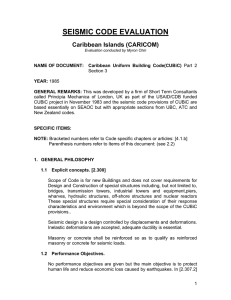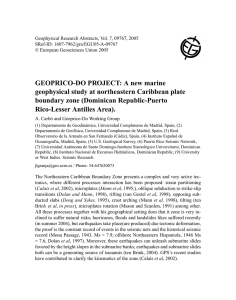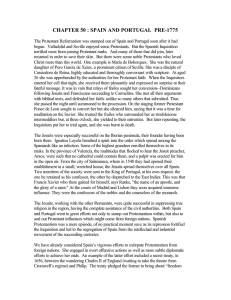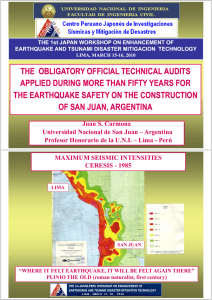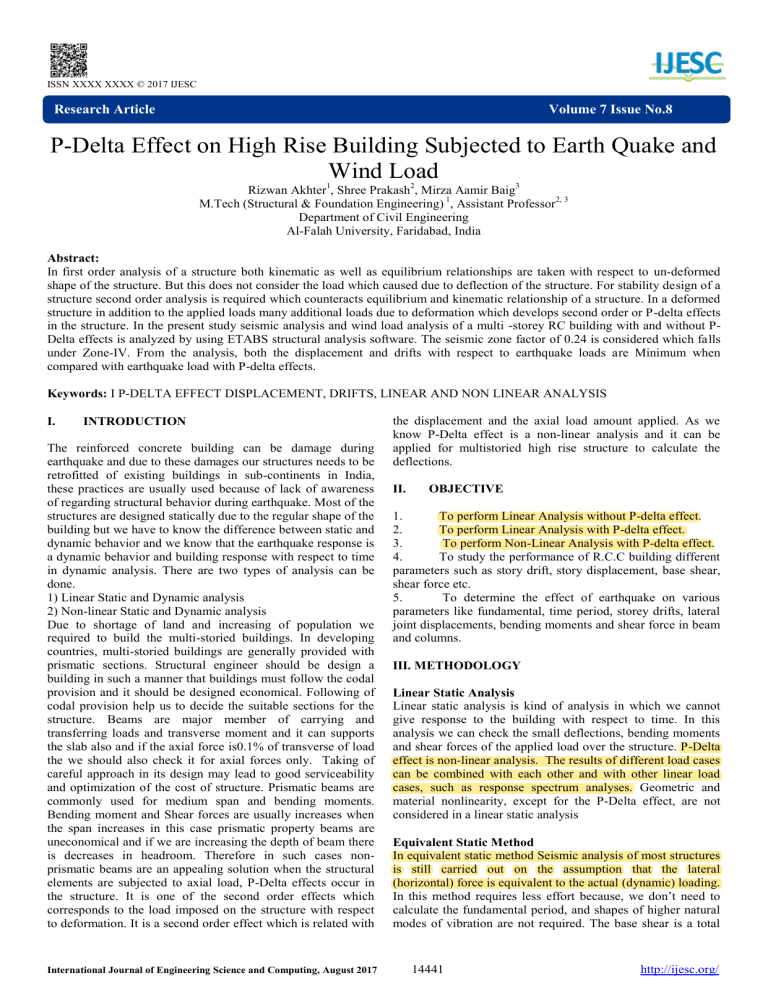
ISSN XXXX XXXX © 2017 IJESC Research Article Volume 7 Issue No.8 P-Delta Effect on High Rise Building Subjected to Earth Quake and Wind Load Rizwan Akhter1, Shree Prakash2, Mirza Aamir Baig3 M.Tech (Structural & Foundation Engineering) 1, Assistant Professor2, 3 Department of Civil Engineering Al-Falah University, Faridabad, India Abstract: In first order analysis of a structure both kinematic as well as equilibrium relationships are taken with respect to un-deformed shape of the structure. But this does not consider the load which caused due to deflection of the structure. For stability design of a structure second order analysis is required which counteracts equilibrium and kinematic relationship of a structure. In a deformed structure in addition to the applied loads many additional loads due to deformation which develops second order or P-delta effects in the structure. In the present study seismic analysis and wind load analysis of a multi -storey RC building with and without PDelta effects is analyzed by using ETABS structural analysis software. The seismic zone factor of 0.24 is considered which falls under Zone-IV. From the analysis, both the displacement and drifts with respect to earthquake loads are Minimum when compared with earthquake load with P-delta effects. Keywords: I P-DELTA EFFECT DISPLACEMENT, DRIFTS, LINEAR AND NON LINEAR ANALYSIS I. INTRODUCTION The reinforced concrete building can be damage during earthquake and due to these damages our structures needs to be retrofitted of existing buildings in sub-continents in India, these practices are usually used because of lack of awareness of regarding structural behavior during earthquake. Most of the structures are designed statically due to the regular shape of the building but we have to know the difference between static and dynamic behavior and we know that the earthquake response is a dynamic behavior and building response with respect to time in dynamic analysis. There are two types of analysis can be done. 1) Linear Static and Dynamic analysis 2) Non-linear Static and Dynamic analysis Due to shortage of land and increasing of population we required to build the multi-storied buildings. In developing countries, multi-storied buildings are generally provided with prismatic sections. Structural engineer should be design a building in such a manner that buildings must follow the codal provision and it should be designed economical. Following of codal provision help us to decide the suitable sections for the structure. Beams are major member of carrying and transferring loads and transverse moment and it can supports the slab also and if the axial force is0.1% of transverse of load the we should also check it for axial forces only. Taking of careful approach in its design may lead to good serviceability and optimization of the cost of structure. Prismatic beams are commonly used for medium span and bending moments. Bending moment and Shear forces are usually increases when the span increases in this case prismatic property beams are uneconomical and if we are increasing the depth of beam there is decreases in headroom. Therefore in such cases nonprismatic beams are an appealing solution when the structural elements are subjected to axial load, P-Delta effects occur in the structure. It is one of the second order effects which corresponds to the load imposed on the structure with respect to deformation. It is a second order effect which is related with International Journal of Engineering Science and Computing, August 2017 the displacement and the axial load amount applied. As we know P-Delta effect is a non-linear analysis and it can be applied for multistoried high rise structure to calculate the deflections. II. OBJECTIVE 1. To perform Linear Analysis without P-delta effect. 2. To perform Linear Analysis with P-delta effect. 3. To perform Non-Linear Analysis with P-delta effect. 4. To study the performance of R.C.C building different parameters such as story drift, story displacement, base shear, shear force etc. 5. To determine the effect of earthquake on various parameters like fundamental, time period, storey drifts, lateral joint displacements, bending moments and shear force in beam and columns. III. METHODOLOGY Linear Static Analysis Linear static analysis is kind of analysis in which we cannot give response to the building with respect to time. In this analysis we can check the small deflections, bending moments and shear forces of the applied load over the structure. P-Delta effect is non-linear analysis. The results of different load cases can be combined with each other and with other linear load cases, such as response spectrum analyses. Geometric and material nonlinearity, except for the P-Delta effect, are not considered in a linear static analysis Equivalent Static Method In equivalent static method Seismic analysis of most structures is still carried out on the assumption that the lateral (horizontal) force is equivalent to the actual (dynamic) loading. In this method requires less effort because, we don’t need to calculate the fundamental period, and shapes of higher natural modes of vibration are not required. The base shear is a total 14441 http://ijesc.org/ horizontal mass which can be calculated by the multiplication of acceleration coefficient and lump mass of the structure. Fundamental time periods should also be calculated and shapes of the building. The base shear can be distributed along the member and the total distribution can be done with respect to height and lump weight. The sum of the distributed forces cannot increases the base shear and we can calculate the overturning moment, displacement, torsion, bending moment and shear forces. Now a days we are using computational programs to calculate the fundamental time period and base shear to avoid the time consumption. Response Spectrum Method This method is also known as Modal Method or Mode SuperPosition Method. In this method we are getting the maximum response of any structure due to earthquake. Basically it is a application of structure in which building response with respect to time and give the accurate result. As per IS18932002 the value response spectrum can be calculated according to the zone factors and importance factor, there are values of Z,I and R have been given in Indian codes and the computational program can calculate the time period according to the soil condition. Generally, this method is applicable to analysis of the dynamic response of structures, which are asymmetrical or have geometrical areas of discontinuity or irregularity, in their linear range of behaviour. Response spectrum method is used to calculate the earthquake forces. Response spectrum plots a graph of peak-steady acceleration. Sinusoidal graph have been taken for response spectrum to calculate earthquake forces. The reversal of load should be taken for response spectrum dynamic analysis because this load is dangerous and will be responsible of building collapse. Response spectra are curves which plots maximum response of SDOF subjected to specified earthquake ground motion. The damping ratio of building are constant for RCC framed structure which is 5% and the value of static base shear should be equal to dynamic base shear for initial analysis to calculate the time period of the building. Non-Liner Static Analysis Nonlinear static analysis are of two types: 1) Geometrical non-linearity 2) Material non-linearity P-Delta is geometrical non-linearity because when the deflection increases we have to test the against the additional forces which are generated by P-Delta effects. The word p is the force and Delta gives the deflection of the particular member on which force p applied. It generates additional shear and bending moment in column and we must design against that. There is one more case for this analysis is Push-over analysis to calculate ultimate load and deflection capability. Material nonlinearity is defined as when the material goes beyond its yield strength and it no longer behaves in linear fashion due to this the material gets cracked, dissipates energy, permanent deformation and beam rotations. There are two ways to specify the initial p-delta analysis in ETAB as follows: Non-iterative Based on Mass: The load is computed automatically from the mass at each level as a story-by-story load upon the structure. This approach is approximate, but does not require an iterative solution. This method is identical to p-delta analysis in ETABS. This method essentially treats the building as a simplified stick model to consider the P-Delta effect. It is much faster than the iterative method. It does not capture local buckling as well as the iterative method. This method works best if you have a single rigid diaphragm at each floor level though it also works for other cases as well. The reason we provide this method is to allow you to consider PDelta in cases where you have not specified gravity loads in your model. If you have specified gravity loads in your model, then in general, we recommend that you use the Iterative Based on Load Cases option. Iterative Based on Load Cases: The load is computed from a specified combination of static load cases. This is called the P-Delta load combination. ¾ PDelta Load Combination: This area is active if you select the Iterative Based on Load Cases option in the Method area of the dialog box. Here you specify the single load combination to be used for the initial P-Delta analysis of the structure. As an example, suppose that the building code requires the following load combinations to be considered for design: (1) 1.4 dead load (2) 1.2 dead load + 1.6 live load (3) 1.2 dead load + 0.5 live load + 1.3 wind load (4) 1.2 dead load + 0.5 live load - 1.3 wind load (5) 0.9 dead load + 1.3 wind load (6) 0.9 dead load - 1.3 wind load For this case, the P-Delta effect due to the overall sway of the structure can usually be accounted for, conservatively, by specifying the P-Delta load combination to be 1.2 times dead load plus 0.5 times live load. This will accurately account for this effect in load combinations 3 and 4 above, and will conservatively account for this effect in load combinations 5 and 6. This P-Delta effect is not generally important in load combinations 1 and 2 since there is no lateral load. Second-order analysis when accounting for P-Delta combines two effects to reach a solution 1. Theory of large displacement: - In this theory both forces and moments due to deformed shape of structure and also members are considered. 2. Stress stiffening: - In this the effect of axial load on structure stiffness is seen. Normally tensile loads straighten the geometry of an element this increases the stiffness whereas compressive loads accentuate deformation which in turn reduces the stiffness of the structure. There are two P-Delta effects: P-“BIG” delta (P-∆) - a structure effect • P-“little” delta (P-δ) - a member effect The magnitude of the P-Delta effect is related to the: • Magnitude of axial load P • Stiffness or slenderness of the structure as a whole • Slenderness of individual elements. P-delta EFFECT P-Delta is a geometrical non-linearity and it give the additional shear forces and bending moment to the structure due the applied force P, whereas P is the load and delta is a lateral deformation. This case is most dominant in case of earthquake instead of wind. This can be checked n P-M interaction diagram of column cross-section. P-Delta is actually only one of many second-order effects. It is a effect that is genuine and associated with the magnitude of the applied axial load (P) and a displacement (delta). International Journal of Engineering Science and Computing, August 2017 14442 http://ijesc.org/ Seismic Loads As per IS-1893-2002, seismic analysis of the structure is performed. The design horizontal seismic coefficient, Ah for the structure has been computed using the following: 1. Zone factor, Z =0.24 (Zone IV) 2. Importance factor I =1.0 3. Response Reduction factor, R =5 4. Soil type = Medium Soil 5. Damping Coefficient = 0.05 6 Time period = .075 H^.75= 0.75 *48.5^0.75= 1.298 sec P-delta effect by axial load STATIC ANALYSIS OF BUILDINGS USING IS 1893 Design Seismic Base ShearThe design base shear is depends on the lump mass of structure and acceleration coefficient. Base shear is total lateral force at a base of the structure and distributed along the member to calculate the serviceability and behaviour. VB= Ah x W Ah = Design horizontal seismic coefficient. W = Seismic weight of the building Seismic Weight of BuildingThe seismic weight of each floor is its full dead load plus appropriate amount of imposed load as specified. The mass source from which e can compute the seismic weight is (DL+0.25LL) up to 3 KN/m2 and (DL+0.5LL) for above 3KN/m2 While computing the seismic weight of each floor, the weight of columns and walls in any story shall be equally distributed to the floors above and below the story. The seismic weight of the whole building is the sum of the seismic weights of all the floors. Any weight supported in between the story shall be distributed to the floors above and below in inverse proportion to its distance from the floors. Fundamental Natural Time Period- The fundamental natural time period (Ta) calculates from the expression Ta = 0.075h^0.75 for RC frame building Ta = 0.085h^0.75 for steel frame building If there is brick filling, then the fundamental natural period of vibration, may be taken as Ta = 0.09h √d Distribution of Design Force- The design Base Shear, VB computed above shall be distributed along the height of the building as per the following expression Qi = Vb*Wi*hi^2 ∑Wj*hj^2 International Journal of Engineering Science and Computing, August 2017 WIND LOAD CALCULATION Basic wind speed= Vb =47m/s Terrain category 2 Risk coefficient = 1 Topography = 1 Design wind speed Vz = Vb*k1*k2*k3 Terrain Category I Plan length = 32 m Plan width = 20 m Height of building = 48.5 m Face width = 20 m Face depth = 35.5 m Interval = 4 m k1 = 1 k2 (at 33.5 m) = 1.00 k3 = 1.00 Vb = 47 m/s Vz = Vb x k1 x k2 x k3 =47 m/s Wind pressure = P=0.6*(Vz)^2=0.6*(47)^2=1.325KN/m^2 4. MODEL CONFIGURATION Table.no.1 R.C.C BUILDING HEIGHT 48.5 m AREA 1300 sqm. Each Story height 3m COLUMN 0.250Mm*0.750Mm (1st to 20th floor) BEAM 250mm*750mm SLAB 150mm GRADE CONCRETE GRADE CONCRETE GRADE CONCRETE GRADE STEEL ZONE OF 25M (SLAB) OF 25M (BEAM) OF 30M(COLUMN) OF FE415 (Rebar) IV REGION DELHI LIVE LOAD 3KN/sqm 14443 http://ijesc.org/ DISPLACEMENT DUE TO EARTH QUAKE WITHOUT P DELTA Story20 Story17 Story14 Story11 Story8 Story5 Story2 DISPLACEMENT 70 60 50 40 30 20 10 0 TH P DELTA STORY CHART.NO.1 X-DIR DISPLACEMENT Figure.1. 3d view 70 60 50 40 30 20 10 0 DISPLACEMENT DUE TO EARTH QUAKE WITHOUT P DELTA WITH P DELTA 1 4 7 10 13 16 19 Figure.2. Plan view of Building STORY 4.1. DISPLACEMENT CHART.NO.2 X-DIR Table.2. DISPLACEMENT DUE TO EARTH QUAKE Story19 57.3 61.2 58.6 62.9 Story18 55.7 59.5 57 61.2 Story17 53.8 57.5 55.1 59.2 Story16 51.5 55.1 52.8 56.8 Story15 49 52.4 50.2 54.1 Story14 46.1 49.4 47.4 51.1 Story13 43.1 46.2 44.3 47.9 Story12 39.9 42.9 41.1 44.4 Story11 36.5 39.3 37.6 40.9 Story10 33 35.7 34.1 37.1 Story9 29.4 32 30.4 33.3 Story8 25.7 28.2 26.7 29.4 Story7 22.1 24.3 22.9 25.4 Story6 18.4 20.5 19.1 21.4 Story5 14.7 16.7 15.2 17.5 Story4 11.1 12.9 11.5 13.5 Story3 7.6 9.2 7.9 9.6 Story2 4.4 5.6 4.5 5.8 Story1 1.6 2.2 1.6 2.3 Base 0 0 0 0 International Journal of Engineering Science and Computing, August 2017 20 WITHOUT P DELTA 10 0 WITH P DELTA STORY CHART NO.3 X-DIR 100 90 80 70 60 50 40 30 20 10 0 DISPLACEMENT DUE TO WIND WITHOUT P DELTA WITH P DELTA Base 64.2 Story4 59.9 Story8 62.5 Story12 58.7 Story16 Story20 30 Story20 Story17 Story14 Story11 Story8 Story5 Story2 Y-DIR DISPLACEMENT DUE TO WIND 40 Story20 X-DIR DISPLACEMENT WITH P-DELTA DISPLACEMENT WITHOUTPDELTA X-DIR Y-DIR 50 STORY CHART NO.4 Y-DIR 14444 http://ijesc.org/ Table.3. DISPLACEMENT DUE TO WIND FORCE 2. This concludes P-delta effects have more effect in designing of a structure rather than first order effect. WITHOUTPDELTA X-DIR Y-DIR WITH P-DELTA X-DIR Y-DIR 3. We can minimize pounding action of two tall buildings with roof displacements. Story20 41.9 84.2 44.1 89.6 Story19 41.3 83 43.5 88.3 Story18 40.5 81.5 42.7 86.8 Story17 39.6 79.6 41.8 84.8 Story16 38.5 77.4 40.6 82.4 Story15 37.2 74.7 39.3 79.7 Story14 35.6 71.7 37.7 76.5 Story13 33.9 68.2 35.9 72.9 Story12 32 64.5 33.9 69 Story11 29.9 60.4 31.7 64.6 Story10 27.6 55.9 29.3 59.9 Story9 25.1 51.1 26.7 54.9 Story8 22.5 46 23.9 49.5 Story7 19.7 40.6 21 43.7 Story6 16.8 35 17.9 37.7 Story5 13.8 29.1 14.6 31.4 Story4 10.6 23 11.3 24.8 Story3 7.5 16.7 7.9 18 Story2 4.3 10.3 4.6 11.1 Story1 1.5 4.2 1.6 4.4 Base 0 0 0 0 BASE SHEAR 2932.10 2 2932.77 25 2835.98 58 EQ-X EQ-Y 2834.19 43 RS-X RS-Y CHART.5. Table.4. Dead Load EQ-X EQ-Y RS-X RS-Y BASE SHEAR 142361.2 2932.773 2835.986 2932.102 2834.194 5. CONCLUSIONS P-delta investigations and linear static analysis are carried out for 18 storey RC framed structure using ETABS. On the basis of results obtained, following conclusions are drawn. 1. Displacements with respect to earthquake load with P-delta effects are maximum when compared with earthquake load. International Journal of Engineering Science and Computing, August 2017 4. Storey displacement values for all the load cases are within the permissible limit. 6. ACKNOWLEDGEMENT First of all I thank the Almighty God, I would like to express my sincerely gratefulness to Mr. MIRZA AAMIR BAIG my thesis Co-guide without whom this project could possibly never have been accomplished. He gives me not only large number of significant advice, guidance and comments, but also motivates supervision and encouragement. There are people without whom this dissertation might not have been possible and to whom I am greatly thankful. Therefore, I would like to acknowledge: My supervisor SHREE PRAKASH, Assistant Professor and Project Guide, Department of Civil Engineering, Al-FALAH University who was not simply supervisors, but also friends and mentors. Without him and his wealth of knowledge, patience and reliability; I could not reach this far. 7. REFERENCES [1]. Mallikarjuna B.N, Ranjith A(2014), “Stability analysis of steel frame structures: p-delta analysis”, IJRET, Vol.03 Issue: 08,Aug-2014, pp 36-40. [2]. Rafael Shehu (2014), “The p-δ-ductility effect: overview the effect of the second order in the ductile structures” European Scientific Journal, Vol.3, 2014, pp 143-155. [3]. Prashant Dhadve, Alok Rao, Atul Rupanvar, Deokate K., Admile P.R, Dr. Nemade. P. D. (2015), “Assessment of PDelta Effect on High Rise Buildings” IJRITCC, May 2015, Vol.3 Issue: 5, pp 3231-3236 [4].Rupali Bondre, Sandeep Gaikwad (2016), “Analysis of structures with respect to linear static analysis using p-delta effects” IJARIIE Vol.2 Issue-4 2016 pp 32313236 [5].Anuj Man Shakya (2011), “P-delta effects on steel moment Frames with reduced beam section Connection” http://op ensiuc.lib.siu.edu/theses [6].Yousuf Dinar, Samiul Karim, Ayan Barua, Ashraf Uddin (2013) “ P-Delta Effect in Reinforced Concrete Structures of Rigid joint” IOSR-JMCE, Vol.10, Issue 4 (Nov. - Dec. 2013), PP 42-49 Farzad Naeim “Design for Drift and Lateral Stability”. [7]. Prof. C. G. Konapure, Mr. P. V. Dhanshetti(2015) “Effect of P-Delta Action on Multi-Storey Buildings”, International Journal of Engineering Research and Technology, Vol.4, Issue 1, January 2014. [8].IS 1893 (Part-II and III): Criteria for Earthquake Resistant Design of Structure, Bureau of ndian Standards, New Delhi [9].IS: 875 (Part-I)-1987 Code of pract ice for design loads (Other than Earthquake) for buildings and structures, Bureau of Indian Standard, New Delhi, India. 14445 http://ijesc.org/ [10].IS 875 (Part-II)-1987. Code of Practice for design loads (other than earthquake) for building and structure, PartII, imposed loads. B S, Manak Bhawan, New Delhi, India. [11].IS 875 (Part-III)-1987, Code of Practice for design loads (other than earthquake) for building and structure‖, Part III, Wind Loads, B S, Manak Bhawan, New Delhi, India. 8. BIOGRAPHY RIZWAN AKHTER, M.Tech (Structural & Foundation Engineering) Department of Civil Engineering AL-FALAH University, Faridabad INDIA SHREE PRAKASH, Assistant Professor, Department of Civil Engineering AL-FALAH University, Faridabad INDIA MIRZA AAMIR BAIG, Assistant Professor, Department of Civil Engineering AL-FALAH University, Faridabad INDIA International Journal of Engineering Science and Computing, August 2017 14446 http://ijesc.org/
